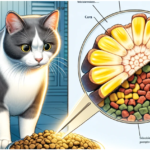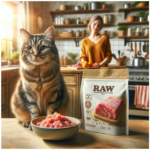Carrageenan has been a topic of much discussion among pet owners and veterinarians alike. This natural ingredient, derived from red seaweed, plays a multifaceted role in the cat food industry. Its inclusion in cat food formulations is not without controversy, prompting a deeper dive into what it is, its purposes in cat food, and the potential health implications it may have for our feline friends.
What Is Carrageenan?
Carrageenan is a polysaccharide extracted from certain types of red seaweed. It’s known for its thickening, gelling, and stabilizing properties. It comes in two main forms: food-grade and degraded. Food-grade is widely used in the food industry, including in pet food, for its ability to improve texture and consistency. Degraded, on the other hand, is not used in food applications due to health concerns.
Why Is Carrageenan Used in Cat Food?
The inclusion of carrageenan in cat food serves multiple purposes:
- Texture and Palatability: It helps in achieving the desired texture in wet cat foods, making them more appealing to cats.
- Moisture Retention: It helps in retaining moisture, ensuring that the cat food remains juicy and palatable over time.
- Stability: It acts as a stabilizer, preventing the separation of ingredients in cat food, thus ensuring uniformity in every bite.
These qualities make it a popular choice among pet food manufacturers, aiming to deliver products that are not only nutritionally complete but also aesthetically pleasing and satisfying to feline consumers.
Potential Health Risks to Cats
The use of carrageenan in cat food has raised concerns among pet owners and researchers due to potential health risks. Studies have suggested that degraded carrageenan, which is different from the food-grade version used in pet foods, can cause gastrointestinal inflammation and other issues in laboratory animals. However, the research on food-grade carrageenan suggests that it is generally safe in the amounts used in cat food.
Some points of contention include:
- Inflammatory Response: There have been studies indicating that carrageenan might trigger an inflammatory response in the digestive system. For cats with sensitive stomachs or underlying health conditions, this could potentially exacerbate issues like inflammatory bowel disease (IBD).
- Cancer Concerns: While there is no direct evidence linking food-grade carrageenan to cancer in cats, the degraded form has been shown to have carcinogenic properties in lab rats. This has led to some extrapolation of potential risks, despite the lack of concrete evidence in cats.
- Regulatory Stance: Organizations such as the Food and Drug Administration (FDA) consider food-grade carrageenan safe for use in food products, including pet food. However, the ongoing debate and emerging research have prompted some pet food companies to reformulate their products without it.
Conclusion
Carrageenan’s role in cat food is multifaceted, offering benefits in terms of texture and stability. However, the ongoing debate over its potential health risks highlights the importance of informed decision-making for pet owners. While current evidence suggests that food-grade carrageenan is safe for use in cat food, individual cat sensitivities and conditions may warrant a more cautious approach. As always, consulting with a veterinarian about the best dietary choices for your cat is advisable, especially if your pet has a history of gastrointestinal issues or other health concerns.
For those looking to delve deeper into the subject or explore carrageenan-free cat food options, reputable sources such as the FDA and scientific journals provide valuable insights and updates on the latest research findings. Remember, the well-being of our feline friends is paramount, and staying informed is key to making the best choices for their health and happiness.
In crafting a well-balanced diet for your cat, consider not only the ingredients but also the quality and source of those ingredients. By doing so, you can ensure that your furry companion enjoys both delicious and nutritious meals.







Your words have a way of resonating deeply with your readers Thank you for always being encouraging and uplifting
I have been struggling with this issue for a while and your post has provided me with much-needed guidance and clarity Thank you so much
I couldn’t stop scrolling and reading, your content is truly one-of-a-kind. Thank you for all the time and effort you put into creating such amazing content.
Your posts always provide me with a new perspective and encourage me to look at things differently Thank you for broadening my horizons
Hi, I do believe your website might be having web browser compatibility problems.
When I look at your web site in Safari, it looks fine but when opening in I.E., it has some overlapping issues.
I simply wanted to give you a quick heads up!
Other than that, great website!
Thanks so much for letting me know! I’m working to correct the problem now.
Useful info. Fortunate me, I discovered your website accidentally. I bookmarked it.
Your article helped me a lot, is there any more related content? Thanks!